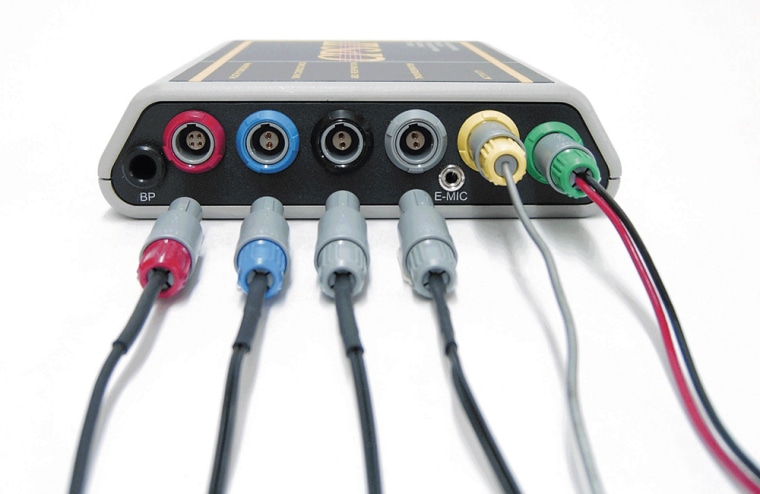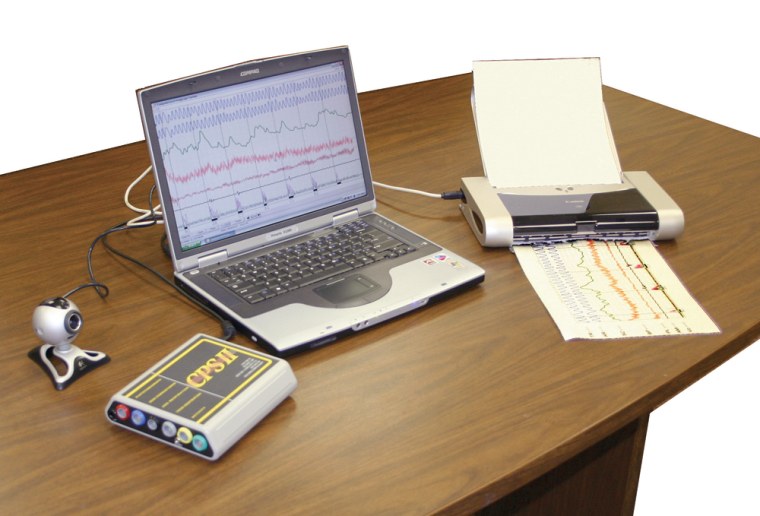We all know people who lie. Sure, there are people who omit the truth, people who keep secrets. But how about those who don’t even blink when asked direct questions?
Employers and law enforcement use polygraphs as a screening tool, but now, if you have about three hours to spare and several hundred dollars, you can engage this service, too.
Anyone who’s ever watched a police/crime procedural TV show — such as “CSI” or “Law & Order” — is familiar with the idea. This is not new technology. It’s been around for more than a century.
Last week, MSNBC.com reported that the Pentagon will issue handheld lie detectors to U.S. soldiers in Afghanistan to screen local police officers, interpreters and allied forces for access to U.S. Military bases. The device may also be used in Iraq.
The debate about polygraphs' reliability is longstanding, and they're not allowed as evidence in most U.S. courts.
Stoelting is one of the major manufacturers of modern polygraphs. In 1935, it came out with the version of lie detectors that we know from earlier movies and TV. Among the other major players in the industry are Axciton, Lafayette and Limestone.
These analog versions were used up until the 1980s, when computerized versions theoretically made it nearly impossible to fool these instruments (do not call them machines; examiners hate that!).
The American Polygraph Association is one place to start if you're a private citizen looking for a polygraph for peace of mind.
Patrick Coffey, a California-based security consultant and computer polygraph examiner, and who specializes in pre-employment and internal affairs investigations experience in the private sector and law enforcement communities, has several tips for first-time consumers:
- Use only the services of a professional polygraph examiner who is a graduate of an American Polygraph Association-accredited school. Graduates of such schools have "usually completed an internship in a law enforcement agency or intelligence service, or a well-respected private sector company which services law enforcement agencies or the armored car service industry," he said.
- Make sure you are employing "a professional polygraph examiner who utilizes current state-of-the-art computer equipment with objective scoring algorithms," he said. The examiner "must know how to hand-score a chart the old-fashioned way, and the subsequent computer scores are always considered only afterward. This provides for both subjective and objective findings."
- "Never use someone who merely owns the equipment, but does not have the actual accredited education and internship experience, or who is not accepted among their professional peer group."
Powered from USB port
Stoelting’s 8 Channel CPS II Computerized Polygraph System is a compact, but powerful device, that allows a trained examiner to do voice and audio recordings, to read a subject’s pulse, to gauge voice responses and the usual markers — all powered from a USB port connector to a computer.
Like Ben Stiller’s interrogation by future father-in-law Robert De Niro in “Meet the Parents,” the subject is hooked up to the device to measure reactions in different ways, including relative changes in blood pressure and pulse rate, perspiration and respiration.
The squiggly lines we’ve seen on TV and movies are still there, but now they’re hooked up to a laptop and software that analyzes microscopic physiological reactions.
The red line still represents cardio readings, green is perspiration and the blue lines measure respiration. Typically, a 10-question script includes four questions about the problem or event and those pivotal queries are compared to six other “control” questions.
More than 'yes' or 'no'
In their reports, Coffey said, examiners give a narrative of the interview, how the person qualified as a test subject, the information they're claiming, which type of test was done, the equipment used (calibrated to the manufacturers' specifications), relevant questions and the examiners' "hand score" (subjective score).
That allows the examiner to see the strength of the "purity" of the lines. Only after that are the scoring algorithms engaged, depending on the information the examiner provides (excluding a random sneeze or cough). The algorithms will compare that data with information it knows to be truthful and deceptive —validated material.

But just because De Niro's character did the test at home on a nervous Ben Stiller, don't think you can do it yourself authoritatively.
APA-accredited schools are located in 10 states, including Arizona, California, Georgia and Maryland.
There are thousands of private investigators in California, for example, but because the state doesn't require licensing for its polygraph examiners, finding one is best done through one of the associations, which can vouch for the training of the examiners.
Only half of the nation's states require licensing for polygraph examiners. If you're unsure, check with the American Polygraph Association's headquarters. They represent more than 3,000 examiners.
